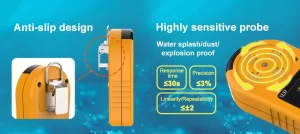The issue of air pollution caused by the emission of harmful gases has become a global concern. The adverse effects of these emissions on human health and the environment are well-documented, making it imperative to develop effective strategies for their control. One of the key components of such strategies is the use of gas sensors, which can detect and measure the concentration of specific gases in the air. Over the years, significant advancements have been made in gas sensor technology, leading to improved performance, sensitivity, and selectivity. In this article, we will explore some of the recent developments in gas sensor technology and their potential applications in emissions control.

Recent Developments in Gas Sensor Technology
One of the most significant advancements in gas sensor technology is the development of nanomaterial-based sensors. Nanomaterials such as metal nanoparticles, carbon nanotubes, and graphene have unique physical and chemical properties that make them ideal for gas sensing applications. These materials offer high surface area, fast electron transport, and strong adsorption sites for target gas molecules, resulting in enhanced sensitivity and selectivity. Moreover, they can be easily functionalized with various chemical groups to improve their response characteristics.
Another important development is the integration of microelectromechanical systems (MEMS) technology into gas sensors. MEMS-based sensors combine microfabrication techniques with traditional gas sensing principles to create miniaturized devices with high precision and accuracy. They can be integrated into portable monitoring systems or used as part of larger environmental monitoring networks. Additionally, MEMS-based sensors can operate at low power consumption levels, making them suitable for long-term deployment in remote areas.
In addition to nanomaterials and MEMS technology
there have been advances in the development of optical gas sensors. Optical sensors use light sources such as ultraviolet or visible light to excite a target gas, which then emits light at a specific wavelength. The intensity of the emitted light is proportional to the concentration of the gas. Optical sensors have several advantages over other types of gas sensors, including fast response times, high sensitivity, and selectivity. They can also be used for multi-gas detection by analyzing the spectral characteristics of the emitted light.
Applications of Gas Sensor Technology in Emissions Control
Gas sensor technology has numerous applications in emissions control, including monitoring air quality, detecting leaks, and ensuring compliance with regulatory standards. Some of the common applications are:
Monitoring Air Quality:
Gas sensors can be used to monitor the concentration of hazardous gases such as carbon monoxide, nitrogen dioxide, sulfur dioxide, and methane in industrial environments. This information can be used to improve ventilation systems, reduce emissions, and protect workers' health. For example, gas sensors can be deployed in indoor environments to detect high concentrations of carbon monoxide from combustion appliances or cooking activities.
Leak Detection:
Gas sensors can be deployed in pipelines, storage tanks, and other equipment to detect leaks before they cause significant damage or harm to the environment. They can also be used to monitor the integrity of natural gas pipelines and prevent explosions caused by gas leaks. Gas sensors can provide real-time data on gas concentrations, enabling rapid response to potential leaks.
Compliance Monitoring:
Many industries are required to comply with regulatory standards regarding the emission of hazardous gases. Gas sensors can be used to monitor these emissions continuously and ensure compliance with regulations. For example, they can be used in wastewater treatment plants to monitor the concentration of volatile organic compounds (VOCs) and prevent discharge into water bodies. Gas sensors can also be used in vehicle exhaust systems to monitor emissions levels and ensure compliance with emission standards.
Hazardous Area Monitoring:
ndustries that handle hazardous materials such as chemicals, petroleum products, and explosives need to monitor their environments for potential risks. Gas sensors can be used to detect the presence of hazardous gases such as hydrogen sulfide, carbon monoxide, and methane in these areas and alert workers to take appropriate action. Gas sensors can also be used in mining operations to monitor the concentration of toxic gases such as carbon dioxide and methane and prevent accidents caused by gas explosions.

Conclusion
Gas sensor technology has come a long way since its inception, with significant advancements being made in recent years. The integration of nanomaterials, MEMS technology, and optical sensors has led to improved performance, sensitivity, and selectivity of gas sensors. These advancements have opened up new possibilities for the application of gas sensor technology in emissions control. By using gas sensors for monitoring air quality, detecting leaks, ensuring compliance with regulatory standards, and monitoring hazardous areas, industries can significantly reduce their environmental impact and enhance worker safety. As research continues in this field, we can expect further advancements in gas sensor technology that will pave the way for more efficient and effective emissions control strategies.
 : +86 155 8830 2704
: +86 155 8830 2704 : jxdziot@gmail.com
: jxdziot@gmail.com
